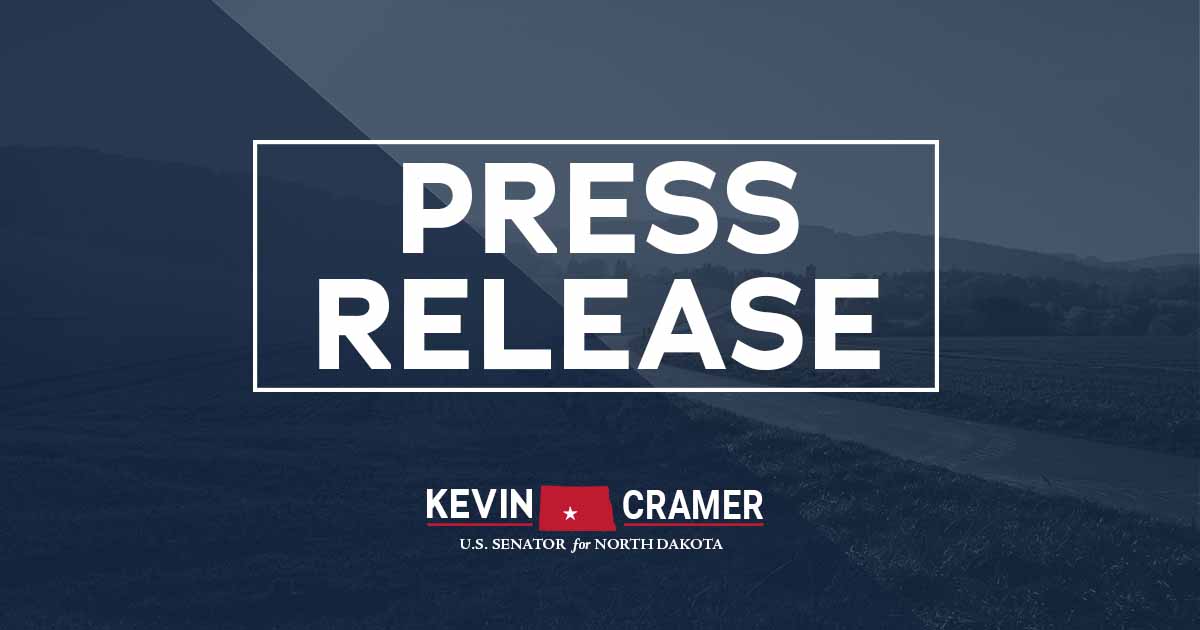Senator Cramer, EPW Leaders Introduce Legislation to Reauthorize U.S. Economic Development Administration
Senator Cramer, EPW Leaders Introduce Legislation to Reauthorize U.S. Economic Development Administration Kevin Cramer


U.S. Economic Development Administration (EDA) Introduces Economic Development Reauthorization Act of 2024

The U.S. Economic Development Administration (EDA), founded in 1965, plays a crucial role in creating and retaining jobs, as well as stimulating growth in economically-distressed communities across the United States. The agency’s programs and initiatives focus on improving local economies through activities such as workforce training and infrastructure development.
However, despite receiving annual funding through the appropriations process, the EDA has not been reauthorized since 2004. This highlights the need for congressional direction over the agency and an update to its mission in order to effectively serve communities nationwide. To address this, U.S. Senators Kevin Cramer (R-ND) and Mark Kelly (D-AZ), along with Senators Shelley Moore Capito (R-WV) and Tom Carper (D-DE), introduced the bipartisan Economic Development Reauthorization Act of 2024. This legislation aims to amend the EDA’s reauthorization, updating funding levels responsibly, emphasizing infrastructure projects, providing opportunities for small rural communities, and supporting locally-driven economic development decisions.
Importance of Reauthorization
“Modernizing the Economic Development Administration’s mission and funding levels is Congress’ responsibility and long overdue,” said Senator Cramer. “This bill provides critical updates to the agency’s programs and initiatives and will better support EDA’s mission to facilitate locally-driven economic growth. This reauthorization emphasizes hard infrastructure and workforce development while including specific reforms to benefit the small, rural communities across North Dakota.”
“The Economic Development Administration is a critical partner for many of our communities, helping to drive investment, create jobs, and grow local economies across West Virginia,” said Senator Capito. “It is past time for Congress to reauthorize the EDA, and I’m excited to partner with Chairman Carper, Senator Cramer, and Senator Kelly to introduce the bipartisan Economic Development Reauthorization Act of 2024. This legislation will help preserve locally-driven economic development decisions and ensure core programs that fund a range of activities, including infrastructure projects, will continue for years to come.”
“The Economic Development Administration is driving our nation’s job growth, building resilient supply chains, and investing in our local economies,” said Senator Carper. “Reauthorizing the EDA will give this critical agency the tools and resources it needs to better support local businesses and organizations and equip our communities with climate-resilient infrastructure, in turn strengthening both local and regional job creation and our competitiveness abroad. I am grateful to my colleagues on both sides of the aisle for their partnership in writing this legislation to empower the EDA for years to come.”
“From providing economic development opportunities in rural and tribal communities, onshoring critical manufacturing supply chains, and permanently authorizing Arizona’s Southwest Border Regional Commission, our bipartisan bill will help communities in every corner of the country thrive,” said Senator Kelly. “In crafting this bill, I heard from Arizona mayors, county supervisors, economic development planners, and business leaders to ensure the Economic Development Administration meets the challenges and opportunities of the future. As chair of the Subcommittee on Transportation and Infrastructure, I appreciate the work that went into this from Republicans and Democrats and look forward to seeing our bipartisan compromise get signed into law.”
North Dakota Priorities Secured by Senator Cramer:
- Includes language in the findings section highlighting challenges faced by rural communities with limited tax revenue in addressing costly infrastructure needs.
- Authorizes EDA, when awarding Public Works and Economic Development grants, to consider how a project may help highly rural communities with a limited tax base address infrastructure needs.
- Allows communities of under 10,000 people to receive EDA grants at 100% federal cost share if they meet one of the existing economic distress criteria.
- Authorizes appropriations of $40 million annually through Fiscal Year 2029 for the Northern Great Plains Regional Authority.
- Increases the authorized funding level for EDA Partnership Planning Grants and raises the federal cost share from 50 to 60%.
Other Key Initiatives Include:
- Increases the authorized funding level for EDA Economic Development and Public Works Grants.
- Increases the authorized funding level for EDA Economic Adjustment Assistance Grants.
- Sets EDA investment priorities into statute, which include critical infrastructure, workforce, innovation & entrepreneurship, and economic resilience.
- Establishes a Workforce Training Grant Program to support workforce development activities.
- Creates an EDA Office of Tribal Economic Development to help Tribal communities access economic development assistance programs.
- Creates an EDA Office of Disaster Recovery and Resiliency to help the agency more effectively administer disaster assistance.
- Authorizes funding for EDA Regional Offices to create Technical Assistance Liaisons to assist any state served by the region.
- Requires a GAO report evaluating the effectiveness of EDA programs.
- Requires a GAO report to Congress on the impact of EDA funding in rural communities.
- Requires a GAO report listing recommendations for simplifying the EDA grant application process.
- Requires EDA to provide a report to Congress within six months detailing how it’s implementing the improvements to the National Environmental Policy Act made by the Fiscal Responsibility Act.
- Requires EDA to implement these changes through rulemaking within two years after the report is submitted to Congress.
Click here for bill text. Click here for a summary.
SDGs, Targets, and Indicators Identified in the Article
| SDGs | Targets | Indicators |
|---|---|---|
| SDG 8: Decent Work and Economic Growth | 8.1: Sustain per capita economic growth in accordance with national circumstances and, in particular, at least 7 percent gross domestic product growth per annum in the least developed countries | No specific indicators mentioned in the article |
| SDG 9: Industry, Innovation, and Infrastructure | 9.1: Develop quality, reliable, sustainable, and resilient infrastructure, including regional and transborder infrastructure, to support economic development and human well-being, with a focus on affordable and equitable access for all | No specific indicators mentioned in the article |
| SDG 11: Sustainable Cities and Communities | 11.4: Strengthen efforts to protect and safeguard the world’s cultural and natural heritage | No specific indicators mentioned in the article |
| SDG 17: Partnerships for the Goals | 17.9: Enhance international support for implementing effective and targeted capacity-building in developing countries to support national plans to implement all the sustainable development goals, including through North-South, South-South, and triangular cooperation | No specific indicators mentioned in the article |
1. Which SDGs are addressed or connected to the issues highlighted in the article?
The SDGs that are addressed or connected to the issues highlighted in the article are SDG 8: Decent Work and Economic Growth, SDG 9: Industry, Innovation, and Infrastructure, SDG 11: Sustainable Cities and Communities, and SDG 17: Partnerships for the Goals.
2. What specific targets under those SDGs can be identified based on the article’s content?
Based on the article’s content, the specific targets that can be identified are:
- Target 8.1: Sustain per capita economic growth in accordance with national circumstances and, in particular, at least 7 percent gross domestic product growth per annum in the least developed countries
- Target 9.1: Develop quality, reliable, sustainable, and resilient infrastructure, including regional and transborder infrastructure, to support economic development and human well-being, with a focus on affordable and equitable access for all
- Target 11.4: Strengthen efforts to protect and safeguard the world’s cultural and natural heritage
- Target 17.9: Enhance international support for implementing effective and targeted capacity-building in developing countries to support national plans to implement all the sustainable development goals, including through North-South, South-South, and triangular cooperation
3. Are there any indicators mentioned or implied in the article that can be used to measure progress towards the identified targets?
No specific indicators are mentioned or implied in the article that can be used to measure progress towards the identified targets.
4. Table: SDGs, Targets, and Indicators
| SDGs | Targets | Indicators |
|---|---|---|
| SDG 8: Decent Work and Economic Growth | 8.1: Sustain per capita economic growth in accordance with national circumstances and, in particular, at least 7 percent gross domestic product growth per annum in the least developed countries | No specific indicators mentioned in the article |
| SDG 9: Industry, Innovation, and Infrastructure | 9.1: Develop quality, reliable, sustainable, and resilient infrastructure, including regional and transborder infrastructure, to support economic development and human well-being, with a focus on affordable and equitable access for all | No specific indicators mentioned in the article |
| SDG 11: Sustainable Cities and Communities | 11.4: Strengthen efforts to protect and safeguard the world’s cultural and natural heritage | No specific indicators mentioned in the article |
| SDG 17: Partnerships for the Goals | 17.9: Enhance international support for implementing effective and targeted capacity-building in developing countries to support national plans to implement all the sustainable development goals, including through North-South, South-South, and triangular cooperation | No specific indicators mentioned in the article |
Behold! This splendid article springs forth from the wellspring of knowledge, shaped by a wondrous proprietary AI technology that delved into a vast ocean of data, illuminating the path towards the Sustainable Development Goals. Remember that all rights are reserved by SDG Investors LLC, empowering us to champion progress together.
Source: cramer.senate.gov

Join us, as fellow seekers of change, on a transformative journey at https://sdgtalks.ai/welcome, where you can become a member and actively contribute to shaping a brighter future.







